2001 BMW SPORT WAGON ECO mode
[x] Cancel search: ECO modePage 3 of 238

Congratulations, and thank you for choosing a BMW.
Thorough familiarity with your vehicle will provide you with enhanced control and
security when you drive it. We therefore have this request:
Please take the time to read this Owner's Manual and familiarize yourself with the
information that we have compiled for you before starting off in your new car. It
contains important data and instructions intended to assist you in gaining maximum
use and satisfaction from the unique range of technical features on your BMW. The
manual also contains information on care and maintenance designed to enhance
operating safety and contribute to maintaining the value of your vehicle throughout
an extended service life.
This Owner's Manual should be considered a permanent part of this vehicle.
It should stay with the vehicle when sold to provide the next owner with important
operating, safety and maintenance information.
This manual is supplemented by a Service and Warranty Information Booklet
(US models) or a Warranty and Service Guide Booklet (Canadian models).
We recommend that you read this publication thoroughly.
Your BMW is covered by the following warranties:
– New Vehicle Limited Warranty
– Limited Warranty Rust Perforation
– Federal Emissions System Defect Warranty
– Federal Emissions Performance Warranty
– California Emission Control System Limited Warranty
Detailed information about these warranties is listed in the Service and Warranty
Information Booklet (US models) or in the Warranty and Service Guide Booklet
(Canadian models).
We wish you an enjoyable driving experience.
BMW AG
Page 23 of 238
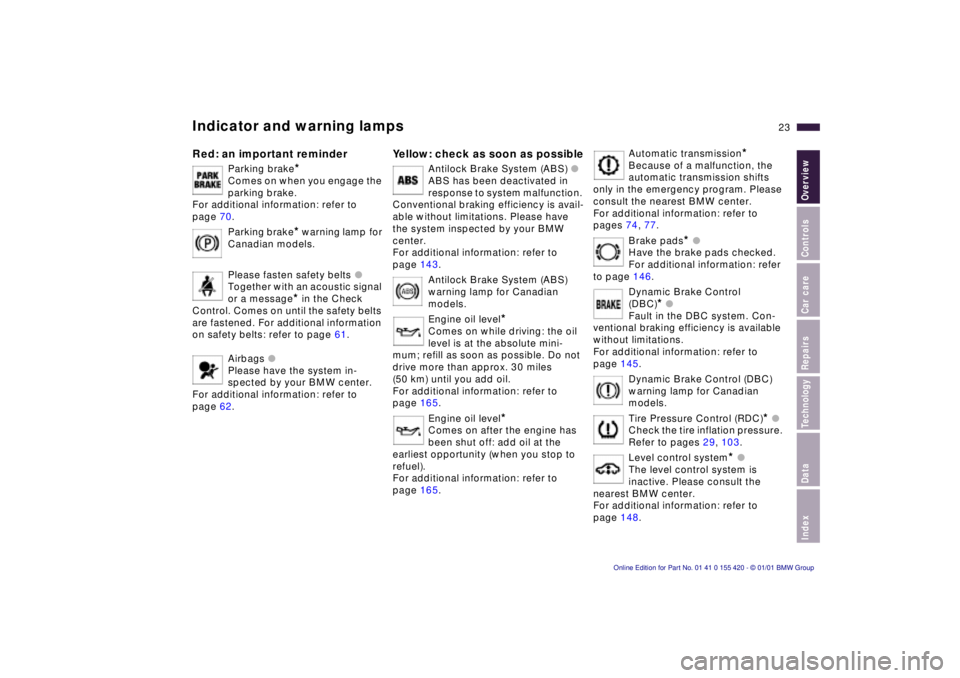
IndexDataTechnologyRepairsCar careControlsOverview
23n
Indicator and warning lampsRed: an important reminder
Parking brake
*
Comes on when you engage the
parking brake.
For additional information: refer to
page 70.
Parking brake
* warning lamp
for
Canadian models.
Please fasten safety belts l
Together with an acoustic signal
or a message
* in the Check
Control. Comes on until the safety belts
are fastened. For additional information
on safety belts: refer to page 61.
Airbags l
Please have the system in-
spected by your BMW center.
For additional information: refer to
page 62.
Yellow: check as soon as possible
Antilock Brake System (ABS) l
ABS has been deactivated in
response to system malfunction.
Conventional braking efficiency is avail-
able without limitations. Please have
the system inspected by your BMW
center.
For additional information: refer to
page 143.
Antilock Brake System (ABS)
warning lamp for Canadian
models.
Engine oil level
*
Comes on while driving: the oil
level is at the absolute mini-
mum; refill as soon as possible. Do not
drive more than approx. 30 miles
(50 km) until you add oil.
For additional information: refer to
page 165.
Engine oil level
*
Comes on after the engine has
been shut off: add oil at the
earliest opportunity (when you stop to
refuel).
For additional information: refer to
page 165.
Automatic transmission
*
Because of a malfunction, the
automatic transmission shifts
only in the emergency program. Please
consult the nearest BMW center.
For additional information: refer to
pages 74, 77.
Brake pads
* l
Have the brake pads checked.
For additional information: refer
to page 146.
Dynamic Brake Control
(DBC)
* l
Fault in the DBC system. Con-
ventional braking efficiency is available
without limitations.
For additional information: refer to
page 145.
Dynamic Brake Control (DBC)
warning lamp for Canadian
models.
Tire Pressure Control (RDC)
* l
Check the tire inflation pressure.
Refer to pages 29, 103.
Level control system
* l
The level control system is
inactive. Please consult the
nearest BMW center.
For additional information: refer to
page 148.
Page 25 of 238
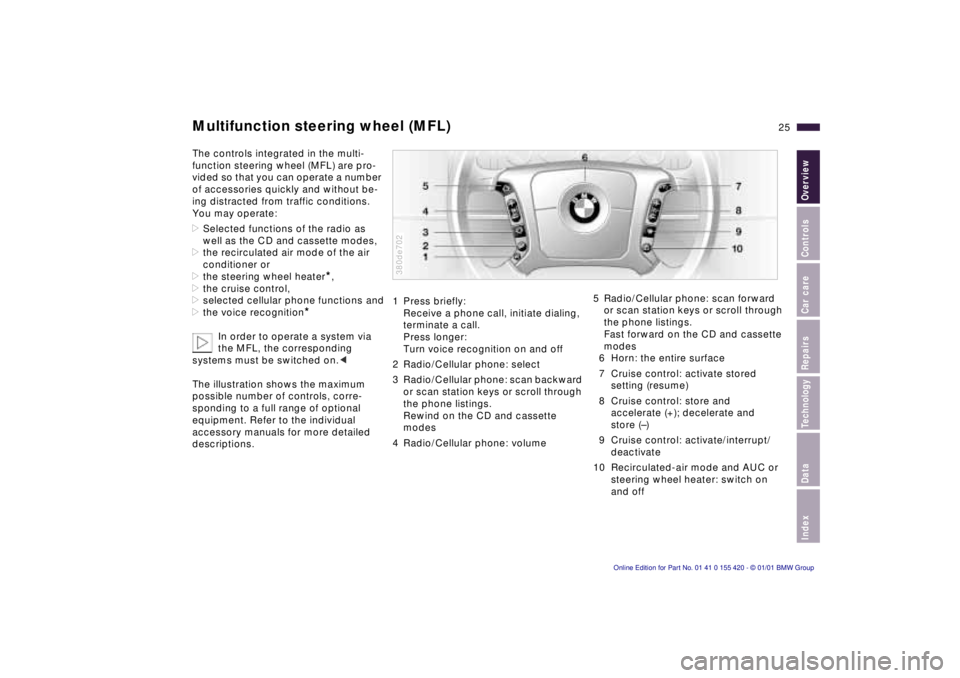
IndexDataTechnologyRepairsCar careControlsOverview
25n
Multifunction steering wheel (MFL)The controls integrated in the multi-
function steering wheel (MFL) are pro-
vided so that you can operate a number
of accessories quickly and without be-
ing distracted from traffic conditions.
You may operate:
>Selected functions of the radio as
well as the CD and cassette modes,
>the recirculated air mode of the air
conditioner or
>the steering wheel heater
*,
>the cruise control,
>selected cellular phone functions and
>the voice recognition
*
In order to operate a system via
the MFL, the corresponding
systems must be switched on.<
The illustration shows the maximum
possible number of controls, corre-
sponding to a full range of optional
equipment. Refer to the individual
accessory manuals for more detailed
descriptions.
1 Press briefly:
Receive a phone call, initiate dialing,
terminate a call.
Press longer:
Turn voice recognition on and off
2 Radio/Cellular phone: select
3 Radio/Cellular phone: scan backward
or scan station keys or scroll through
the phone listings.
Rewind on the CD and cassette
modes
4 Radio/Cellular phone: volume380de702
5 Radio/Cellular phone: scan forward
or scan station keys or scroll through
the phone listings.
Fast forward on the CD and cassette
modes
6 Horn: the entire surface
7 Cruise control: activate stored
setting (resume)
8 Cruise control: store and
accelerate (+); decelerate and
store (–)
9 Cruise control: activate/interrupt/
deactivate
10 Recirculated-air mode and AUC or
steering wheel heater: switch on
and off
Page 26 of 238
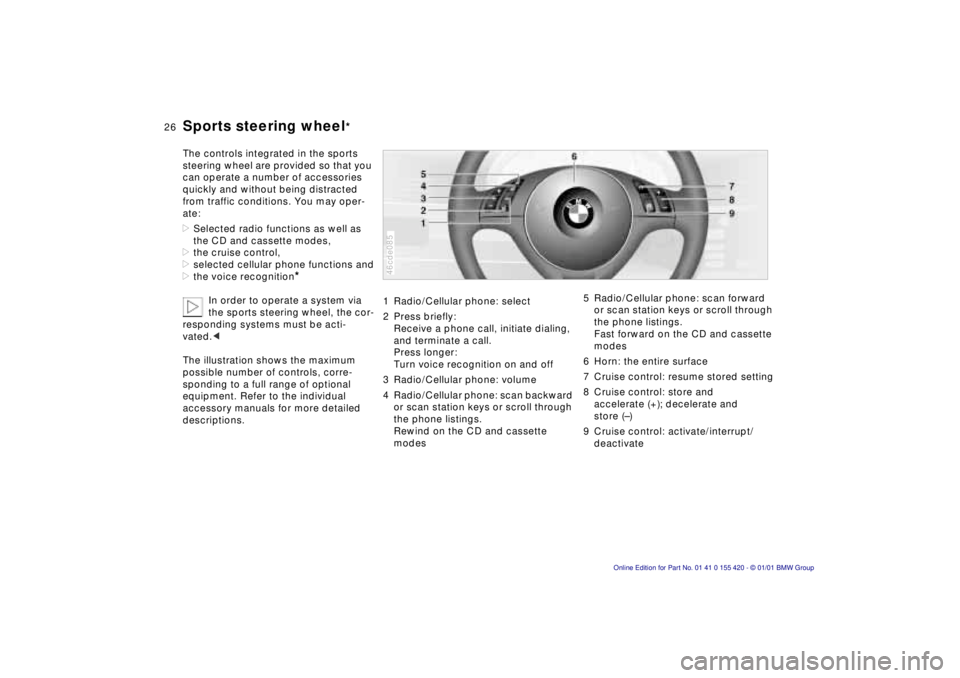
26n
Sports steering wheel
*
The controls integrated in the sports
steering wheel are provided so that you
can operate a number of accessories
quickly and without being distracted
from traffic conditions. You may oper-
ate:
>Selected radio functions as well as
the CD and cassette modes,
>the cruise control,
>selected cellular phone functions and
>the voice recognition
*
In order to operate a system via
the sports steering wheel, the cor-
responding systems must be acti-
vated.<
The illustration shows the maximum
possible number of controls, corre-
sponding to a full range of optional
equipment. Refer to the individual
accessory manuals for more detailed
descriptions.
1 Radio/Cellular phone: select
2 Press briefly:
Receive a phone call, initiate dialing,
and terminate a call.
Press longer:
Turn voice recognition on and off
3 Radio/Cellular phone: volume
4 Radio/Cellular phone: scan backward
or scan station keys or scroll through
the phone listings.
Rewind on the CD and cassette
modes46cde085
5 Radio/Cellular phone: scan forward
or scan station keys or scroll through
the phone listings.
Fast forward on the CD and cassette
modes
6 Horn: the entire surface
7 Cruise control: resume stored setting
8 Cruise control: store and
accelerate (+); decelerate and
store (–)
9 Cruise control: activate/interrupt/
deactivate
Page 39 of 238
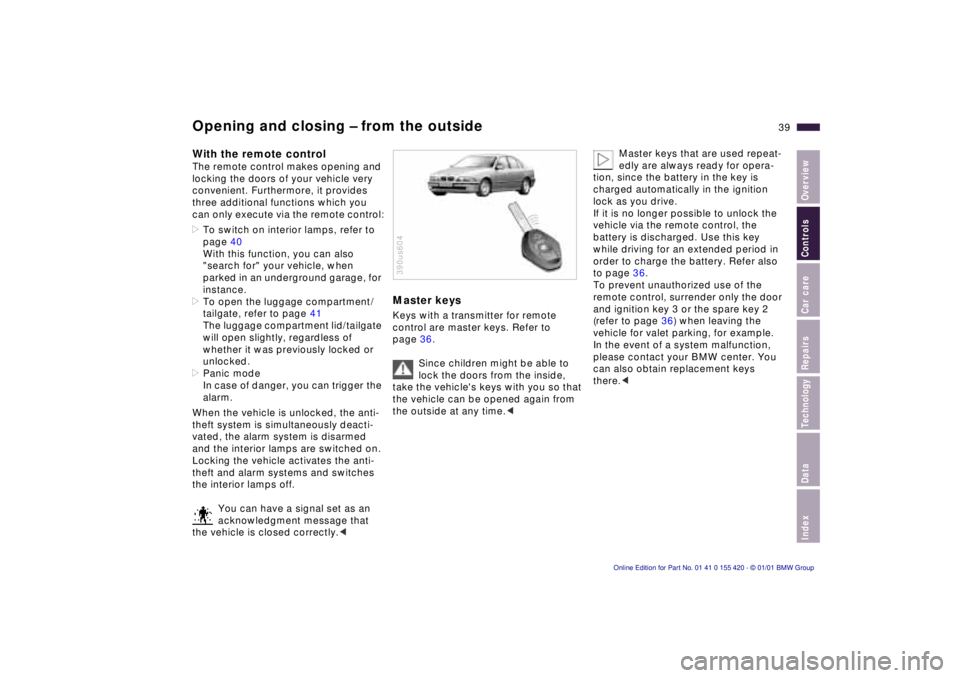
IndexDataTechnologyRepairsCar careControlsOverview
39n
Opening and closing – from the outsideWith the remote controlThe remote control makes opening and
locking the doors of your vehicle very
convenient. Furthermore, it provides
three additional functions which you
can only execute via the remote control:
>To switch on interior lamps, refer to
page 40
With this function, you can also
"search for" your vehicle, when
parked in an underground garage, for
instance.
>To open the luggage compartment/
tailgate, refer to page 41
The luggage compartment lid/tailgate
will open slightly, regardless of
whether it was previously locked or
unlocked.
>Panic mode
In case of danger, you can trigger the
alarm.
When the vehicle is unlocked, the anti-
theft system is simultaneously deacti-
vated, the alarm system is disarmed
and the interior lamps are switched on.
Locking the vehicle activates the anti-
theft and alarm systems and switches
the interior lamps off.
You can have a signal set as an
acknowledgment message that
the vehicle is closed correctly.<
Master keysKeys with a transmitter for remote
control are master keys. Refer to
page 36.
Since children might be able to
lock the doors from the inside,
take the vehicle's keys with you so that
the vehicle can be opened again from
the outside at any time.< 390us604
Master keys that are used repeat-
edly are always ready for opera-
tion, since the battery in the key is
charged automatically in the ignition
lock as you drive.
If it is no longer possible to unlock the
vehicle via the remote control, the
battery is discharged. Use this key
while driving for an extended period in
order to charge the battery. Refer also
to page 36.
To prevent unauthorized use of the
remote control, surrender only the door
and ignition key 3 or the spare key 2
(refer to page 36) when leaving the
vehicle for valet parking, for example.
In the event of a system malfunction,
please contact your BMW center. You
can also obtain replacement keys
there.<
Page 40 of 238
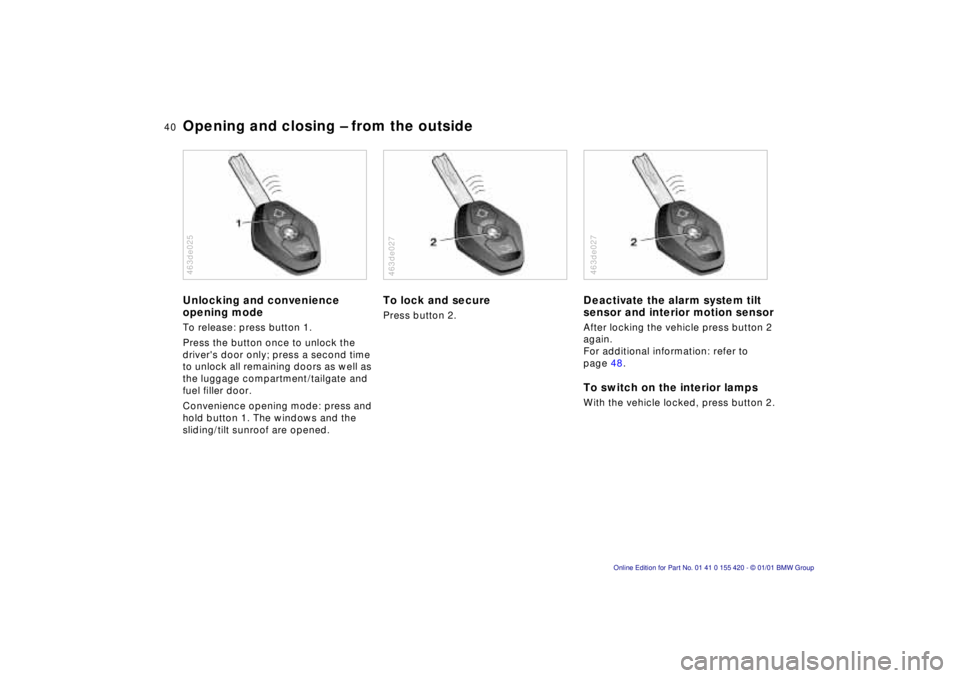
40n
Opening and closing – from the outsideUnlocking and convenience
opening modeTo release: press button 1.
Press the button once to unlock the
driver's door only; press a second time
to unlock all remaining doors as well as
the luggage compartment/tailgate and
fuel filler door.
Convenience opening mode: press and
hold button 1. The windows and the
sliding/tilt sunroof are opened.463de025
To lock and securePress button 2.463de027
Deactivate the alarm system tilt
sensor and interior motion sensorAfter locking the vehicle press button 2
again.
For additional information: refer to
page 48.To switch on the interior lampsWith the vehicle locked, press button 2.380us646463de027
Page 41 of 238
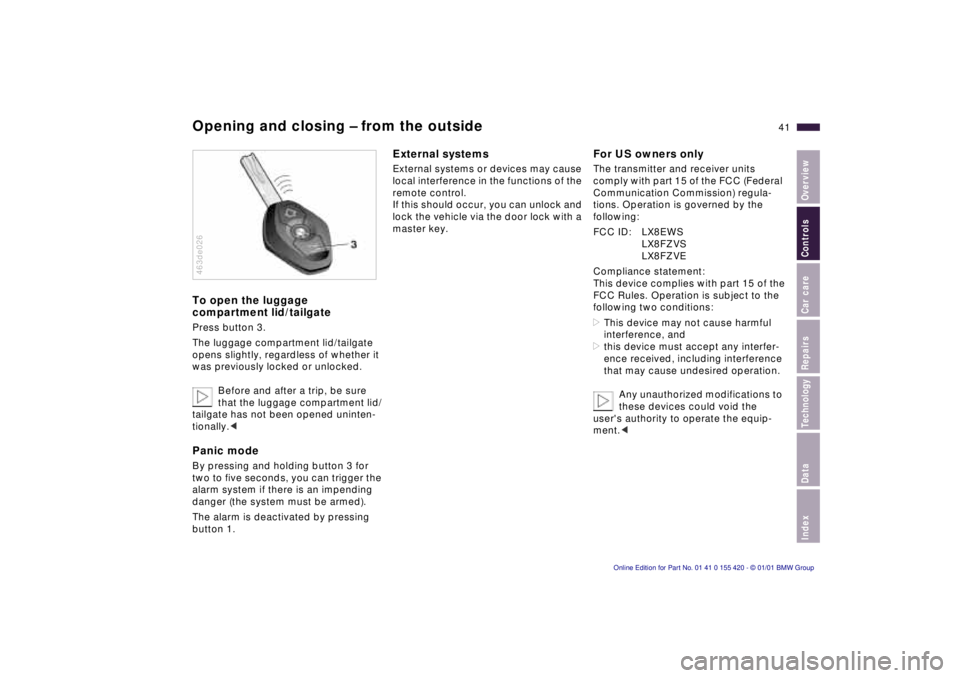
IndexDataTechnologyRepairsCar careControlsOverview
41n
Opening and closing – from the outsideTo open the luggage
compartment lid/tailgatePress button 3.
The luggage compartment lid/tailgate
opens slightly, regardless of whether it
was previously locked or unlocked.
Before and after a trip, be sure
that the luggage compartment lid/
tailgate has not been opened uninten-
tionally.< Panic modeBy pressing and holding button 3 for
two to five seconds, you can trigger the
alarm system if there is an impending
danger (the system must be armed).
The alarm is deactivated by pressing
button 1.463de026
External systemsExternal systems or devices may cause
local interference in the functions of the
remote control.
If this should occur, you can unlock and
lock the vehicle via the door lock with a
master key.
For US owners onlyThe transmitter and receiver units
comply with part 15 of the FCC (Federal
Communication Commission) regula-
tions. Operation is governed by the
following:
FCC ID: LX8EWS
LX8FZVS
LX8FZVE
Compliance statement:
This device complies with part 15 of the
FCC Rules. Operation is subject to the
following two conditions:
>This device may not cause harmful
interference, and
>this device must accept any interfer-
ence received, including interference
that may cause undesired operation.
Any unauthorized modifications to
these devices could void the
user's authority to operate the equip-
ment.<
Page 49 of 238
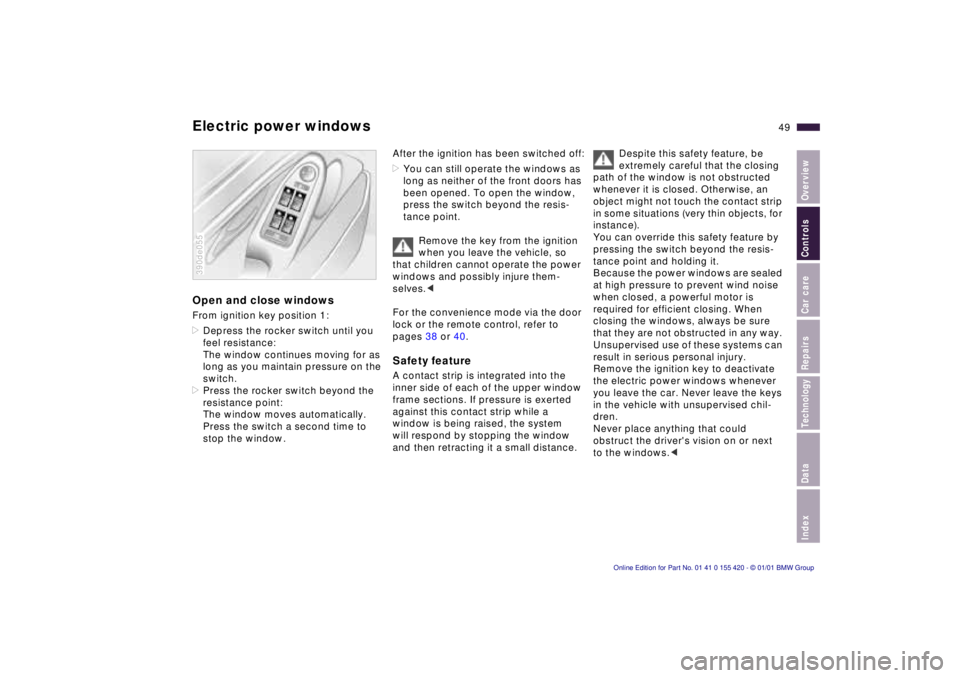
IndexDataTechnologyRepairsCar careControlsOverview
49n
Electric power windowsOpen and close windowsFrom ignition key position 1:
>Depress the rocker switch until you
feel resistance:
The window continues moving for as
long as you maintain pressure on the
switch.
>Press the rocker switch beyond the
resistance point:
The window moves automatically.
Press the switch a second time to
stop the window.390de055
After the ignition has been switched off:
>You can still operate the windows as
long as neither of the front doors has
been opened. To open the window,
press the switch beyond the resis-
tance point.
Remove the key from the ignition
when you leave the vehicle, so
that children cannot operate the power
windows and possibly injure them-
selves.<
For the convenience mode via the door
lock or the remote control, refer to
pages 38 or 40.Safety featureA contact strip is integrated into the
inner side of each of the upper window
frame sections. If pressure is exerted
against this contact strip while a
window is being raised, the system
will respond by stopping the window
and then retracting it a small distance.
Despite this safety feature, be
extremely careful that the closing
path of the window is not obstructed
whenever it is closed. Otherwise, an
object might not touch the contact strip
in some situations (very thin objects, for
instance).
You can override this safety feature by
pressing the switch beyond the resis-
tance point and holding it.
Because the power windows are sealed
at high pressure to prevent wind noise
when closed, a powerful motor is
required for efficient closing. When
closing the windows, always be sure
that they are not obstructed in any way.
Unsupervised use of these systems can
result in serious personal injury.
Remove the ignition key to deactivate
the electric power windows whenever
you leave the car. Never leave the keys
in the vehicle with unsupervised chil-
dren.
Never place anything that could
obstruct the driver's vision on or next
to the windows.<